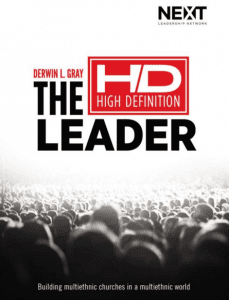 High definition salvation means the “homogenous unit principle,” so characteristic of some megachurches, has got to give way to the HD Principle: salvation is for all and each church is to present that all-are-one-in-Christ to the community. So says Derwin Gray in The High Definition Leader: Building Multiethnic Churches in a Multiethnic World. Derwin caught this vision in a vision inspired by the Bible:
High definition salvation means the “homogenous unit principle,” so characteristic of some megachurches, has got to give way to the HD Principle: salvation is for all and each church is to present that all-are-one-in-Christ to the community. So says Derwin Gray in The High Definition Leader: Building Multiethnic Churches in a Multiethnic World. Derwin caught this vision in a vision inspired by the Bible:
Before Transformation Church ever existed, she existed in my heart. I could picture a congregation of white people, Asian people, black people, Latino people, and every other kind of people: young, old, poor, middle class, and rich. 44
Leading to this mission statement for Transformation Church:
We decided that Transformation Church would be a Great Commandment-Great Commission local church empowered by the great grace and life of our Lord Jesus. We say our vision like this: Transformation Church is a multiethnic, multigenerational, mission-shaped community that loves God completely (Upward), ourselves correctly (Inward), and our neighbors compassionately (Outward) To make our vision memorable we say, “Upward, Inward, Outward” because what’s memorable is portable. 45
He tells the story of the apostle Paul. One of his major themes here is the failure of so many Jewish Christians to see the multiethnic vision that the church was to be in the powerful grace of God. Hear, hear:
If the government, higher education, and corporations such as Google or Apple were as segregated as the church in America, there would a huge public outcry. Yet the church in America marches along, focused on “numerical growth over the biblical value of reconciliation and justice.” 48-49
Paul, he explains, moved from racist to gracist. This happened because of Paul’s eschatology, which Derwin sums up this way: “A vision of the future transforms what you do today” (43). Derwin knows the statements in the ancient world that reify racism and divisions and segmented society, and he knows Paul’s vision for the church was for that situation and would challenge that situation. It was no easier for him than for us today.
His book is Ephesians, and the vision of Ephesians is to bring down the wall of separation because in Christ we are all one. Ephesians 2:14-22.
All of this over against the race-stained Homogenous Unit Principle:
In 1955, Donald McGavran’s book The Bridges of God launched what we know today as the church growth movement. The HUP taught that “homogeneous churches grow faster because people prefer to attend church with those from similar racial, socioeconomic, ethnic and cultural backgrounds. In an attempt to draw individuals into church, barriers needed to removed, and that meant that dealing with racial differences which would detract from the real work of Church would not be considered.” 61















